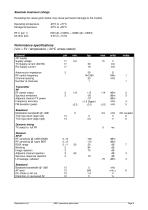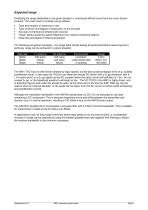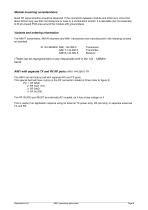
Catalog excerpts

flM) RADIOMETRIX We’re sorry, this linage Is temporarily The narrow band AiM1 transceiver offers a lo w power, reliable data link in a Radiometrix transceiver standard pin out and footprint. The AiM1 is a frequency programmable, narrowband design, suitable for licensed and unlicensed VHF allocations and 2M amateur band applications. Conforms to EN 300 220-3 and EN 301 489-3 (lOmW version only) ■ Standard frequency 144.390MHz ■ Other frequencies from 120MHz to 175MHz: see BiMI B ■ Data rates up to 5kbps for standard module ■ Usable range over 1 km ■ Low power requirements ■ 25kHz Channel spacing ■ Feature-rich interface (true analogue and/or digital baseband) The AiM1 is a half duplex radio transceiver module for use in long range bi-directional data transfer applications at ranges up to 1kilometres. AiM1 is available for operation on the amateur 144MHz band allocation as standard. AiM1 is also available as separate AiM1T transmitter and AiM1R receiver, which can be, used as dual-in-line equivalents of TX1 transmitter and RX1/NRX1 receiver respectively. Applications ■ Amateur radio ■ APRS systems ■ Packet operation ■ FM simplex telephony ■ Repeater monitoring Technical Summary ■ Fully integrated sigma-delta PLL synthesizer based design ■ High stability TCXO reference ■ Receiver sensitivity: -120dBm (for 12dB SINAD) ■ RSSI output with >50dBm range ■ Supply: 3.3V - 15V @ 30mA transmit, 18mA receive ■ Dimensions: 33 x 23 x 9mm Evaluation platforms: NBEK + BiM / SMX carrier Radiometrix Ltd., AiM1 transceiver data
Open the catalog to page 1
Figure 2: AiM1 schematics Radiometrix Ltd., AiM1 transceiver data sheet
Open the catalog to page 2
The transmit section of the AiM1 consists of a highly integrated sigma delta (fractional N) synthesizer based single chip RF device, configured over an SPI serial bus by an on-board microcontroller. The primary frequency reference for the transmitter is a 30MHz VC-TCXO. Modulation is applied directly to this reference via an AF baseband filter (rather than using the chip's internal modulator) to permit a wider range of baseband data rates and waveforms. Operation is controlled by the N_TXE line, the transmitter achieving full RF output typically within 5ms of this line being pulled low. The...
Open the catalog to page 3
Exceeding the values given below may cause permanent damage to the module. Performance specifications: (Vcc = 5V/ temperature = 20 °C unless stated) General DC supply Supply voltage TX Supply current (20mW) RX Supply current Antenna pin impedance RF centre frequency Channel spacing Number of channels Transmitter RF RF power output Spurious emissions Adjacent channel TX power Frequency accuracy FM deviation (peak) Baseband Modulation bandwidth @ -3dB TXD input level (logic low) TXD input level (logic high) Dynamic timing TX select to full RF Receiver RF/IF RF sensitivity @ 12dB SINAD RF...
Open the catalog to page 4
1. Programs to any frequency with in the 120 - 175MHz range 2. Measured into 50Q. resistive loads. 3. Exceeds EN/EMC requirements at all frequencies. 4. 5ppm TCXO. Total over full supply and temperature range. 5. With 0V - 3.0V modulation input. 6. To achieve specified FM deviation. 7. See applications information for further details. 8. For received signal with ±3kHz FM deviation. Radiometrix Ltd., AiM1 transceiver data sheet Page 5
Open the catalog to page 5
Applications information Power supply requirements The AiM1 have built-in regulators which deliver a constant 3.3V to the transmitter and the receiver circuitry when the external supply voltage exceeds 3.3V. This ensures constant performance up to the maximum permitted rail, and removes the need for external supply decoupling, except in cases where the supply rail is extremely poor (ripple/noise content >0.1Vp-p). The unit will continue to function with a 3v supply, but power output will fall". TX modulation requirements The module is factory-set to produce the specified FM deviation with a...
Open the catalog to page 6
Expected range Predicting the range obtainable in any given situation is notoriously difficult since there are many factors involved. The main ones to consider are as follows: • Type and location of antennas in use • Type of terrain and degree of obstruction of the link path • Sources of interference affecting the receiver • “Dead” spots caused by signal reflections from nearby conductive objects • Data rate and degree of filtering employed The following are typical examples - but range tests should always be performed before assuming that a particular range can be achieved in a given...
Open the catalog to page 7
Module mounting considerations Good RF layout practice should be observed. If the connection between module and antenna is more than about 20mm long use 50Ω microstrip line or coax or a combination of both. It is desirable (but not essential) to fill all unused PCB area around the module with ground plane. Variants and ordering information The AiM1T transmitters, AiM1R receivers and AiM1 transceivers are manufactured in the following variants as standard: At 144.390MHz: AiM1-144.390-5 AiM1T-144.390-5 AiM1R-144.390-5 Transceiver Transmitter Receiver (These can be reprogrammed on any...
Open the catalog to page 8
Copyright notice This product data sheet is the original work and copyrighted property of Radiometrix Ltd. Reproduction in whole or in part must give clear acknowledgement to the copyright owner. Limitation of liability The information furnished by Radiometrix Ltd is believed to be accurate and reliable. Radiometrix Ltd reserves the right to make changes or improvements in the design, specification or manufacture of its subassembly products without notice. Radiometrix Ltd does not assume any liability arising from the application or use of any product or circuit described herein, nor for...
Open the catalog to page 9All Radiometrix catalogs and technical brochures
-
LNM2H
13 Pages
-
NiM1B
13 Pages
-
VX2M
9 Pages
-
WRX2C
9 Pages
-
MSR3
8 Pages
-
LMR0
10 Pages
-
SAT3
5 Pages
-
NTX2B
13 Pages
-
NTX0
8 Pages
-
MTX3
10 Pages
-
MTX2
10 Pages
-
BiM3H
8 Pages
-
QPX1
8 Pages
-
QPT1
8 Pages
-
Universal Evaluation Kit
27 Pages
-
TDL2A Evaluation Kit
4 Pages
-
SPM2/RPM Evaluation Kit
7 Pages
-
SP2 Evaluation Kit
12 Pages
-
M48A Application Board
12 Pages
-
M1144
8 Pages
-
DXT / DXR
7 Pages
-
Control44 Evaluation Kit
7 Pages
-
CTA28 App. boards
11 Pages
-
BL118
7 Pages
-
BD118
5 Pages
-
PAN1311
2 Pages
-
PAN1310
2 Pages
-
m48a
11 Pages
-
LMR2
11 Pages
-
TDL3F
10 Pages
-
krx2
9 Pages
-
KTX2
8 Pages
-
RPM3
15 Pages
-
ENX1
11 Pages
-
NiM2
11 Pages
-
BiM1
15 Pages
-
RX3G
6 Pages
-
PLR2
12 Pages
-
MSR3
8 Pages
-
CXR2
12 Pages
-
COR3
8 Pages
-
TX2S
7 Pages
-
CXT2
12 Pages
-
KRX2
9 Pages
-
KFX2
4 Pages
-
KDEC
5 Pages
-
TXL2
11 Pages
-
Radiometrix
20 Pages




















































